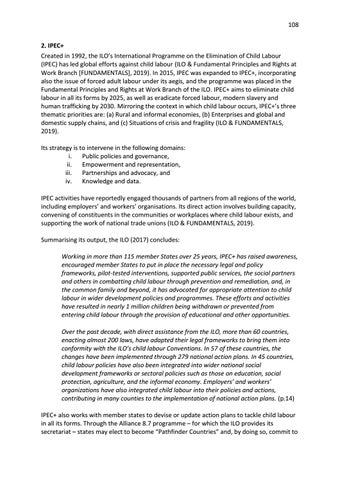108 2. IPEC+ Created in 1992, the ILO’s International Programme on the Elimination of Child Labour (IPEC) has led global efforts against child labour (ILO & Fundamental Principles and Rights at Work Branch [FUNDAMENTALS], 2019). In 2015, IPEC was expanded to IPEC+, incorporating also the issue of forced adult labour under its aegis, and the programme was placed in the Fundamental Principles and Rights at Work Branch of the ILO. IPEC+ aims to eliminate child labour in all its forms by 2025, as well as eradicate forced labour, modern slavery and human trafficking by 2030. Mirroring the context in which child labour occurs, IPEC+’s three thematic priorities are: (a) Rural and informal economies, (b) Enterprises and global and domestic supply chains, and (c) Situations of crisis and fragility (ILO & FUNDAMENTALS, 2019). Its strategy is to intervene in the following domains: i. Public policies and governance, ii. Empowerment and representation, iii. Partnerships and advocacy, and iv. Knowledge and data. IPEC activities have reportedly engaged thousands of partners from all regions of the world, including employers’ and workers’ organisations. Its direct action involves building capacity, convening of constituents in the communities or workplaces where child labour exists, and supporting the work of national trade unions (ILO & FUNDAMENTALS, 2019). Summarising its output, the ILO (2017) concludes: Working in more than 115 member States over 25 years, IPEC+ has raised awareness, encouraged member States to put in place the necessary legal and policy frameworks, pilot-tested interventions, supported public services, the social partners and others in combatting child labour through prevention and remediation, and, in the common family and beyond, it has advocated for appropriate attention to child labour in wider development policies and programmes. These efforts and activities have resulted in nearly 1 million children being withdrawn or prevented from entering child labour through the provision of educational and other opportunities. Over the past decade, with direct assistance from the ILO, more than 60 countries, enacting almost 200 laws, have adapted their legal frameworks to bring them into conformity with the ILO’s child labour Conventions. In 57 of these countries, the changes have been implemented through 279 national action plans. In 45 countries, child labour policies have also been integrated into wider national social development frameworks or sectoral policies such as those on education, social protection, agriculture, and the informal economy. Employers’ and workers’ organizations have also integrated child labour into their policies and actions, contributing in many counties to the implementation of national action plans. (p.14) IPEC+ also works with member states to devise or update action plans to tackle child labour in all its forms. Through the Alliance 8.7 programme – for which the ILO provides its secretariat – states may elect to become “Pathfinder Countries” and, by doing so, commit to
5 0 Billion Euros: Europe's Child Labour Footprint in 2019

Turn static files into dynamic content formats.
Create a flipbookArticles inside
Issuu converts static files into: digital portfolios, online yearbooks, online catalogs, digital photo albums and more. Sign up and create your flipbook.












